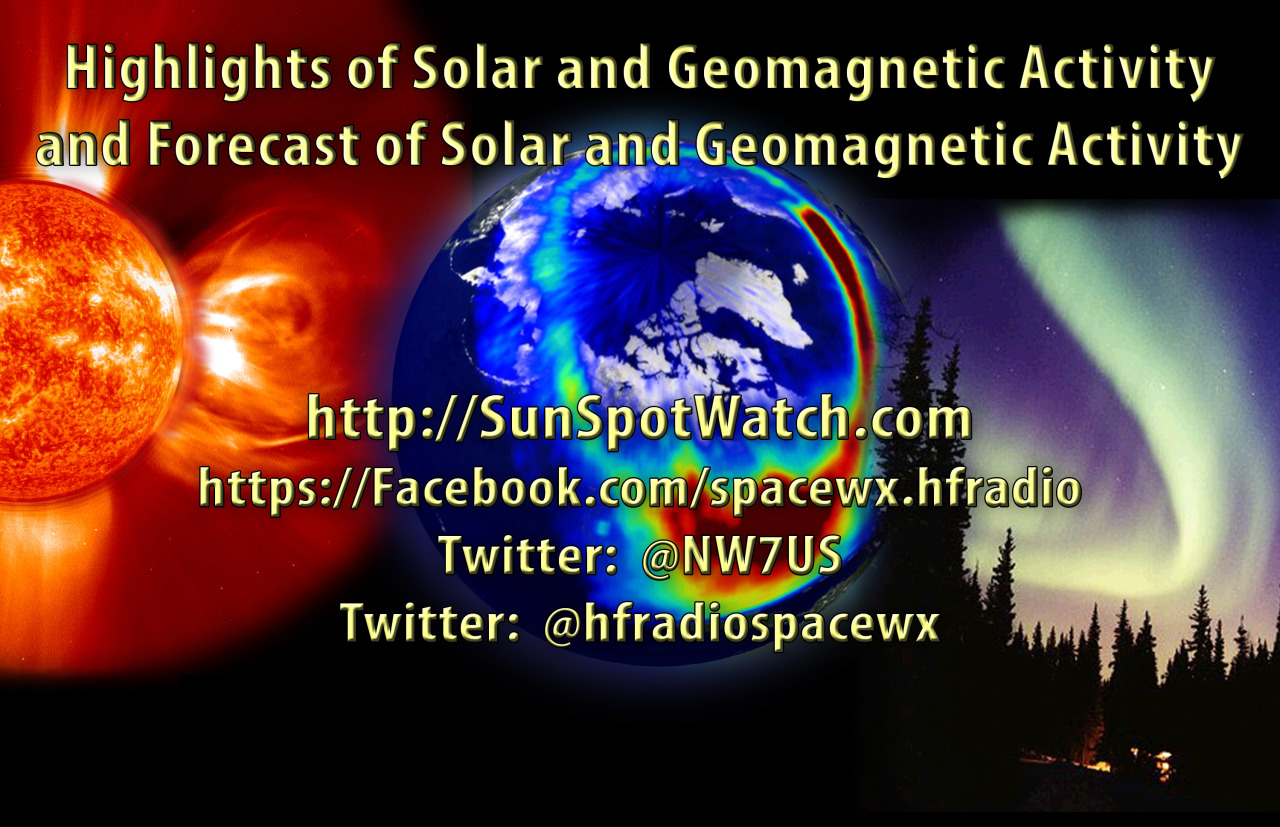 Weekly Propagation Summary – 2015 Apr 27 16:10 UTC
Weekly Propagation Summary – 2015 Apr 27 16:10 UTC
Here is this week’s space weather and geophysical report, issued 2015 Apr 27 0348 UTC.
Highlights of Solar and Geomagnetic Activity
20 – 26 April 2015
Solar activity was at low to high levels throughout the period.
Region 2322 (N11, L=116, class/area=Dac/60 on 21 April) grew and
intensified as it rotated to the western limb; producing numerous
low level C-class flares and five moderate level M-class flares on
21 April. Region 2322 also produced the largest flare of the period,
an impulsive M4/Sf at 22/1545 UTC. Region 2322 continued to produce
C-class and M-class flares until it rotated beyond the western limb
by 24 April, including a long-duration M1 flare at 23/1007 UTC with
an associated Type-II radio sweep and coronal mass ejection (CME)
from the western limb as observed in SOHO/LASCO C2 imagery. The CME
was not Earth-directed.
Regions 2325 (N05, L=050, class/area=Cai/220 on 19 April) and 2326
(N20, L=086, class/area=Cao/80 on 23 April) were the other most
prolific flare producers during the period. Region 2325 produced an
M1 flare at 21/2201 UTC and Region 2326 produced numerous C-class
X-ray flares with the most notable being a C7 flare at 23/1203 UTC.
Both flares were very impulsive and did not have any observed
optical flares nor notable radio signatures.
No proton events were observed at geosynchronous orbit.
The greater than 2 MeV electron flux at geosynchronous orbit was at
moderate to high levels during the week; reaching high levels on
20-21 April and 24 April with a peak flux of 2,620 pfu on 20 April.
Geomagnetic field activity was at quiet to unsettled levels on 20
April as Earth was in a background ambient solar wind environment.
On 21 April, Earth came under the influence of an isolated positive
coronal hole high speed stream (CH HSS) and solar wind speeds
increased to over 600 km/s as measured at the ACE satellite. This CH
HSS produced occasional periods of active levels of geomagnetic
activity from 21-24 April. The CH HSS rotated out of a geo-effective
alignment by midday on 24 April and the winds decreased to mainly
nominal solar wind conditions of about 375 km/s, returning Earth to
quiet to unsettled geomagnetic conditions.
During the week, ACE solar wind parameters measured a high wind
speed of 628 km/s on 21/0632 UTC and a low wind speed of 291 km/s on
26/1123 UTC. Total field (Bt) ranged from about 1 to 14 nT, while
the Bz component varied between +12 to -7 nT. The phi angle was
generally in a positive (away from the Sun) orientation with a short
period of negative (towards the Sun) sector to begin the week.
Forecast of Solar and Geomagnetic Activity
27 April – 23 May 2015
Solar activity is expected to be at very low to low levels through
03 May due to the low number of complex active regions. Solar
activity levels are expected to increase to low levels; with a
slight chance for moderate (R1-R2/minor-moderate) levels beginning
04 May with the return of Region 2322 (N11, L=116) and remain at low
levels, but increase to a chance for moderate (R1-R2/minor-moderate)
levels beginning 07 May as Region 2326 (N20, L=086) also rotates
back onto the disc. Solar activity level is expected to decrease
back to very low to low levels with the departure of Regions 2322
and 2326 beginning 17 May.
No proton events are expected at geosynchronous orbit.
The greater than 2 MeV electron flux at geosynchronous orbit is
expected to be at normal to moderate levels from 27 April-06 May,
normal levels from 07-12 May, moderate to high levels from 13-14
May, high levels from 15-18 May, moderate levels from 19-20 May, and
moderate to high levels from 21-23 May.
Geomagnetic field activity is expected to be at quiet levels from
27-28 April and increase to quiet to unsettled levels beginning 29
April due to CH HSS effects. Field activity is expected to begin
decreasing by 02 May, with overall quiet levels likely from 03-10
May. Field activity is expected to increase to unsettled to active
levels beginning late on 11 May and likely reaching active levels on
12-13 May due to CH HSS effects. Field activity is expected to
decrease to unsettled to active levels by 14 May as CH HSS effects
begin to wane; and return to quiet to unsettled conditions from
15-17 May. Field conditions are expected to increase to unsettled to
active levels on 18 May due to a CH HSS and return to quiet to
unsettled conditions as the CH HSS rotates out of a geo-effective
position by 21 May, and remain at quiet levels for the remainder of
the outlook period.
Don’t forget to visit our live space weather and radio propagation web site, at: http://SunSpotWatch.com/
Live Aurora mapping is at http://aurora.sunspotwatch.com/
If you are on Twitter, please follow these two users:
+ https://Twitter.com/NW7US
+ https://Twitter.com/hfradiospacewx
Get the space weather and radio propagation self-study course, today. Visit http://nw7us.us/swc for the latest sale and for more information!
We’re on Facebook: http://NW7US.us/swhfr













